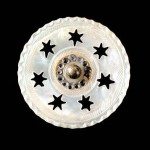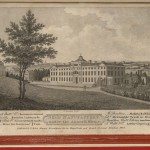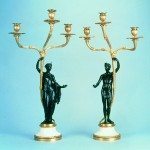Toys in Birmingham
Image: Button made from Shell, Copper, Glass and Brass c. 1790-1800.
This example shows both the intricate nature of toy manufacturing and the variety of materials that would often be used to create one item. Buttons were worn by men rather than by women. They are difficult to date unless they were made from silver and therefore hallmarked.
Image from: Birmingham Museum & Art Gallery
1. Toys in Birmingham
In the 18th and 19th centuries the manufacture of “toys” was a major industry in Birmingham. But these “toys” had nothing to do with children’s games. The term “Birmingham toys” refers to a multitude of small, decorative personal accessories. Their production provided work for thousands, gained major export markets and led to the development of manufacturing techniques which could be applied in other fields. Birmingham’s first directory, Sketchley’s Directory of 1767, lists 100 firms in the “toy” and related trades and describes the industry as follows:
….for the information of Strangers we shall here observe, that these Articles are divided into several Branches, as the Gold and Silver Toy Makers, who make Trinkets, Seals, Tweezer and Tooth Pick cases, Smelling Bottles, Snuff Boxes, and Filigree Work, such as Toilets, Tea Chests, Inkstands, etc. etc. The Tortoise Toy maker, makes a beautiful variety of the above and other Articles; as does also the Steel, who makes Cork Screws, Buckles, Draw and other Boxes, Snuffers, Watch Chains, Stay Hooks, Sugar Knippers, etc., and almost all these are likewise made in various Metals, and for Cheapness, Beauty and Elegance no Place in the world can vie with them.1
1Sketchleys Birmingham Directory, 1767
« Previous in this sectionNext in this section »Continue browsing this section
 Birmingham: “The Toyshop of Europe”
Birmingham: “The Toyshop of Europe”
 Toys in Birmingham
Toys in Birmingham
 John Taylor and Matthew Boulton
John Taylor and Matthew Boulton
 The Soho Manufactory: From Snow Hill to Handsworth
The Soho Manufactory: From Snow Hill to Handsworth
 The Soho Manufactory: The Ingenious Mr Boulton
The Soho Manufactory: The Ingenious Mr Boulton
 The Soho Manufactory: Industrial Tourism
The Soho Manufactory: Industrial Tourism
 The Soho Insurance Society: Ahead of its time
The Soho Insurance Society: Ahead of its time
 Birmingham Toys: Makers and Materials
Birmingham Toys: Makers and Materials
 Birmingham Toys: The Hallmark
Birmingham Toys: The Hallmark
 Birmingham Toys: Made at Soho
Birmingham Toys: Made at Soho
 Birmingham Toys: “Cut Steel”
Birmingham Toys: “Cut Steel”
 Birmingham Toys: Manufacturing Techniques
Birmingham Toys: Manufacturing Techniques
 Salesmen, Customers and Competitors: The Home Market
Salesmen, Customers and Competitors: The Home Market
 Salesmen, Customers and Competitors: Export Markets
Salesmen, Customers and Competitors: Export Markets
 Salesmen, Customers and Competitors: Travelling Salesmen
Salesmen, Customers and Competitors: Travelling Salesmen
 Salesmen, Customers and Competitors: Agents
Salesmen, Customers and Competitors: Agents
 Summary and Developments
Summary and Developments






